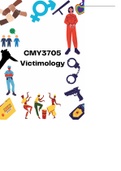Summary
Summary CMY3705 Victimology Study Notes
- Course
- Institution
Comprehensive study notes of the CMY3705 study guide. Summarised in a fun layout from Unit 2 to make the work seem less and keep your attention. Definitions are coloured in green to make them stand out and for you to memorise it easily. Easy layout to read and comprehend.
[Show more]



